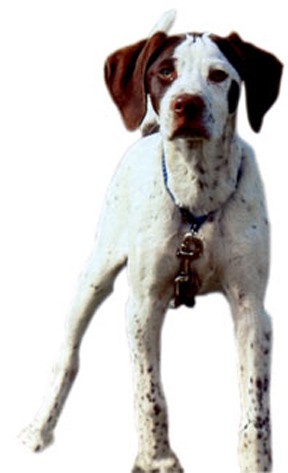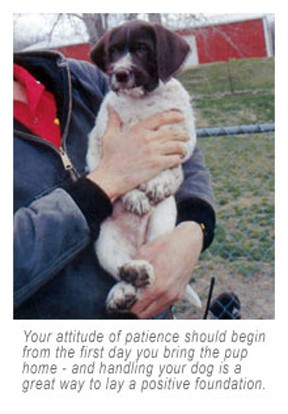



The Dangers of Anger



The Silent Command System rarely uses any voice commands or vocal cues in the early stages of training. One good reason not to use your voice is that silence inhibits anger. Think about it- what’s the first thing you do when you get frustrated in any situation? For example, you’re driving down the highway and someone passes you and then cuts you off, forcing you to use the brakes. Or perhaps it’s a driver going 35mph and there’s no room for you to pass and you’re in a hurry. Do you smile, relax and say, “Oh well, that’s no big deal”? Probably not; instead you react with frustration, raise your voice, and use some rather colorful and expressive language. The longer the situation goes on, the more frustrated you get, and the louder your voice becomes. While this may be satisfying to a point when you’re behind the wheel, it has not place in dog training because the voice very clearly indicates anger, and anger affects your dog’s ability to trust and learn from you.
"The last thing you need is a dog that is afraid to even try to learn or take your direction because it fears your reaction. If you get angry when trying to teach your dog something new, it’s usually because your are frustrated that your dog isn’t doing things right."
Why is anger bad? Because it creates resistance, fear and mistrust. The last thing you need is a dog that is afraid to even try to learn or take your direction because it fears your reaction. If you get angry when trying to teach your dog something new, it’s usually because your are frustrated that your dog isn’t doing things right. Remember, if the dog doesn’t understand what you want, it’s because your haven’t explained it clearly enough. That makes it your problem, not your dog’s problem. You’re the teacher; don’t lose patience with your dog because of a failure to communicate.
Whenever we punish a dog for an incorrect response to something that is has not yet learned, we create fear. That dog will, after a few angry corrections, be afraid to respond for fear of more corrections. Let’s look at an example of this from the human perspective: Suppose there is a young child in the first grade. The subject is math, and the math problem is 2+2. The child says the answer is five and the teacher says no. Teacher repeats the question and the child guesses six. The teacher smacks to child on the arm and angrily says, “no”! and asks once again. Cautiously, the child guesses three, and the teacher reaches out and grasps the child’s shirt collar and shakes the poor kid, shouting, “You are so stupid! How can you know that the answer is four?” By this time, the kid is afraid to even try to give another answer for fear of the teacher’s anger and frustration. Okay, so it a bit on an extreme example, but you get the point.
As a parent, would you consider this an appropriate way for your child to learn? What went wrong here? IN this situation, the fault lies with the teacher, who never bothered to teach the child to count first, than show the child two objects, add two more, and have the child count again, making it obvious that the correct response is four, showing the student how to arrive at the correct answer. It’s not the pupil’s fault that the teacher failed to teach.
Keep this in mind when you work with your dog. If something’s not going right, ask your self: Does the dog have the basic knowledge it needs for this to make senses, or do I need to back up and redo some of the earlier steps? If my dog has the basic knowledge but still doesn’t understand what I want, how can I break this down into smaller steps and make it more clear.
Remember, if you dog doesn’t understand, it is always the fault of the teacher for not being clear and not properly preparing the dog for the task.
It’s important to recognize where anger comes from so we can prevent and control it. In training or teaching situations, anger stems mainly from frustration. Why do we get frustrated? Because we want things to be right and be perfect, and when things don’t go our sway, we get annoyed. What is important to realize is this: We have the power to make things work our just as perfectly as we want them to be, if only we will take the time to think it through and do it right.
It’s easy to justify getting frustrated with your dog. After all, they aren’t as smart as we are, so it has to be their lack of superior intelligence that is the problem, right? Wrong. We humans are the intelligent ones, so it’s our job to be able to understand the much more simple level our dog is on. The only way to do this effectively it to leave anger and frustration out of the process altogether.
It’s easy to justify getting frustrated with your dog. After all, they aren’t as smart as we are, so it has to be their lack of superior intelligence that is the problem, right? Wrong. We humans are the intelligent ones, so it’s our job to be able to understand the much more simple level our dog is on. The only way to do this effectively it to leave anger and frustration out of the process altogether.
Always train with no emotion. When you start to feel frustrated, stop training immediately. Put your dog away, and take some time to think and sort through what you were doing, figure out what went wrong, and decide what to do to fix it. Think about what the dog needs to succeed at the lesson, and then determine whether or not you have given the dog the tools to succeed. Have this plan in mind before you work the dog again. Don’t’ continue working with your dog while you are angry. If you allow your frustration o take over, it will damage the trust you have with your dog and set your training back substantially.
Training with anger or frustration creates resistance in you dog. Because of the fear of punishment, the dog will learn to resist the learning process. Once the behavioral pattern of resistance has been set, it is difficult to erase. It can be done – with infinite patience and a new attitude on the part of the handler – but it is much easier to not create the problem to begin with. Eliminating your voice from early training will limit your ability to show anger, and it will allow your dog to learn with confidence. Be careful not to confuse correction with punishment; corrections are applied for behaviors that the dog knows well, and a correction will make sense to your dog because it already has the knowledge of what is expected. Punishment, on the other hand, is simply a know-jerk reaction to our frustration; it has no place in training.
How can you tell if anger has affected a dog? Read the dog’s body language. How does the dog react when you reach for it? A dog that crouches, cringes, pins it ears back and looks down or away, tucks the tail and dies not want it, or does not want to be approached is showing mistrust. A confident, trusting dog will stand steadily, wagging its tail and looking up at the handler with a happy expression.
If your dog is showing some of these negative signs, how do you backtrack and try to fix the problem? Go back to the basics and start over as if the dog has never been trained. Leave all emotion completely out of the picture, and start by expecting nothing.
Take lots of “happy walks,” do a good amount of just petting and handling and do not real work or training, Have no expectations; the only goals at this point is to regain trust, not to train.
If anyone is in training at this point, it is the handler! Take, as much time as it takes there is no magic amount of time to regain trust. Once the dog consistently shows signs of trust and confidence, move on to simple talks such as heeling on the a lead, and as the dog continues to exhibit trust and confidence in you, gradually move on the other facets of training. Leave all emotion completely out of the training process.
Anger creates fear and mistrust, and once instilled in a god, it can never be completely erased. I f you to the rehab work, than lose you temper just one time, all of the dog’s negative reflexes will come right back to the surface. The easiest way to prevent this from happening is to not create the problem the first time around. Keep all emotion out of your training session.